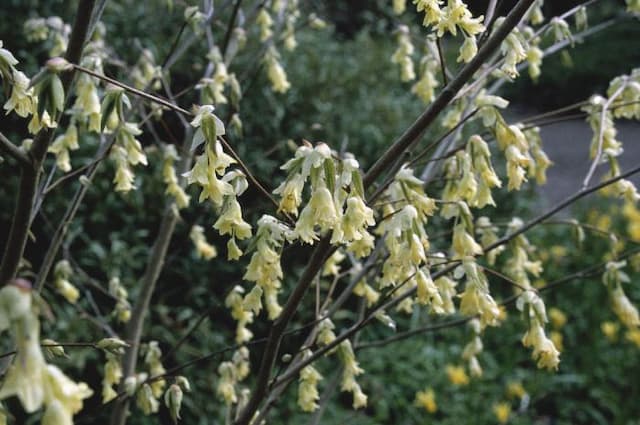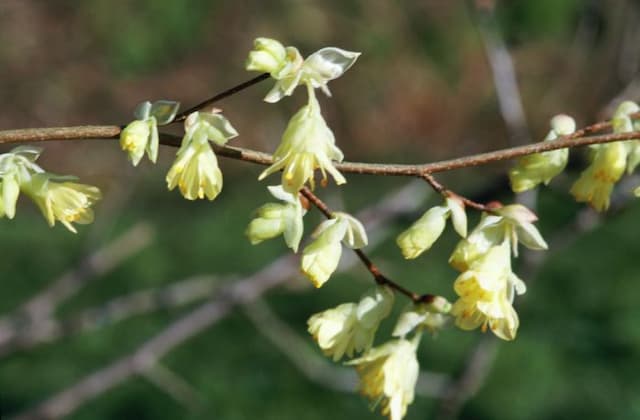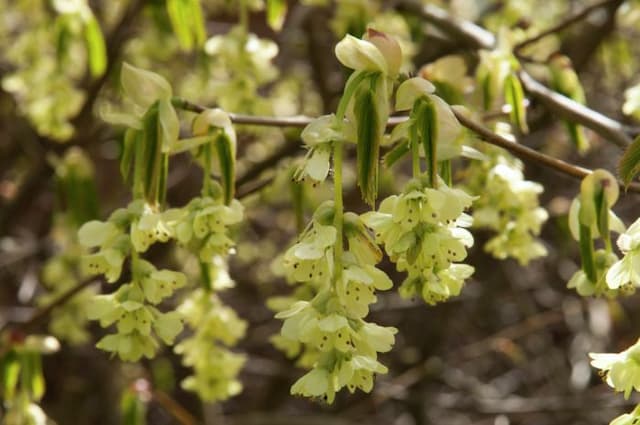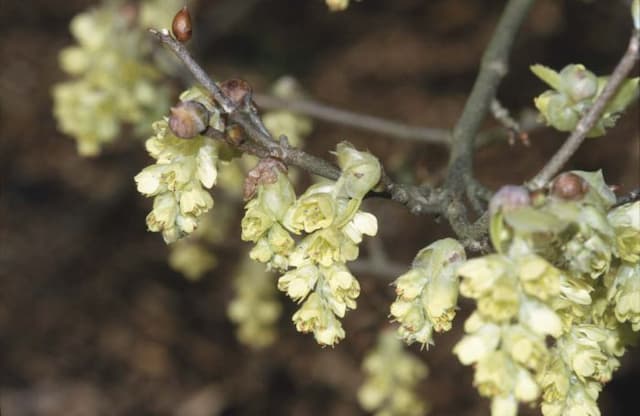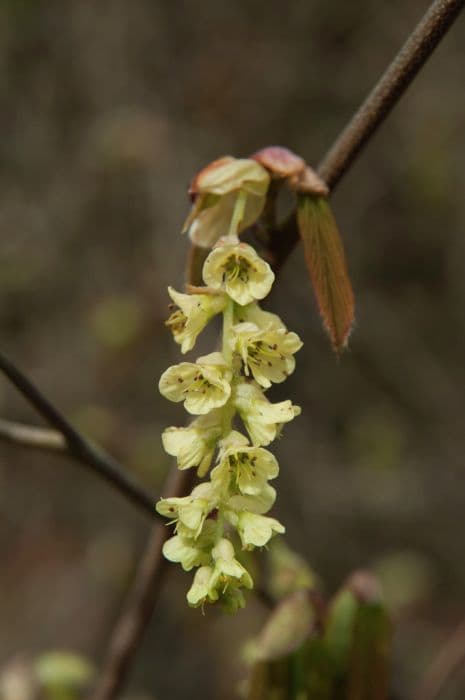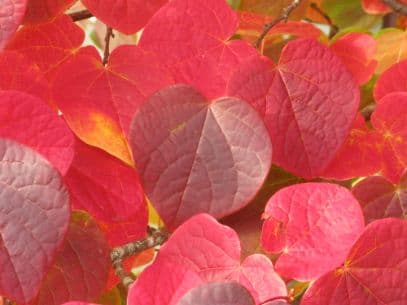Chinese Winter Hazel Corylopsis sinensis var. sinensis

ABOUT
The Chinese Winter Hazel, typically presents a deciduous shrub form, known for its attractive foliage and sweetly scented flowers. It showcases simple, ovate to rounded leaves, with a delicate soft texture and a bright to pale green color, which can transition to shades of yellow or gold in the fall, adding seasonal interest. When the Chinese Winter Hazel blooms, usually early in the spring before the leaves unfurl, it displays chains of buttery yellow flowers. These flowers dangle gracefully from the branches like small bells or tassels, imparting a subtle, yet delightful fragrance. The show of blooms provides a welcome contrast against the bare stems in the landscape. The branching pattern of this plant is open and spreading, with the branches often arching, creating a layered appearance. Bark is smooth and can range from a grayish to brown color, which may not be overly conspicuous but adds to the plant's multi-seasonal display. The general shape of the Chinese Winter Hazel is rounded to vase-shaped, and it is often used in gardens for its overall graceful structure, attractive foliage, and the charming floral show in late winter to early spring. It's a favored specimen for those looking for plants that provide early color and interest in the garden, especially after a long, cold winter.
About this plant
 Names
NamesFamily
Hamamelidaceae
Synonyms
Chinese Winter Hazel, Chinese Filbert
Common names
Corylopsis sinensis var. sinensis.
 Toxicity
ToxicityTo humans
The Chinese winter hazel is not commonly known to be toxic to humans. There have been no widespread reports of poisoning or adverse effects from ingesting parts of the Chinese winter hazel. As with any plant, individual allergies or sensitivities could potentially cause reactions, but generally, this plant is considered safe around humans with no known toxicity.
To pets
Similar to its effect on humans, the Chinese winter hazel is not commonly known to be toxic to pets. There are no significant reports of pets being poisoned by consuming parts of the Chinese winter hazel. However, it is always wise to prevent pets from ingesting plants as individual animals could have unique sensitivities or allergic reactions.
 Characteristics
CharacteristicsLife cycle
Perennials
Foliage type
Deciduous
Color of leaves
Green
Flower color
Yellow
Height
8-15 feet (2.4-4.6 meters)
Spread
6-12 feet (1.8-3.7 meters)
Plant type
Shrub
Hardiness zones
6
Native area
China
Benefits
 General Benefits
General Benefits- Aesthetic Appeal: Corylopsis sinensis, commonly known as Chinese winter hazel, has attractive drooping clusters of yellow flowers in early spring, which add color and beauty to gardens and landscapes.
- Pollinator Attraction: The flowers of Chinese winter hazel are a valuable early-season nectar source for bees and other pollinators when few other plants are in bloom.
- Ornamental Foliage: Chinese winter hazel offers year-round interest with its foliage, which includes attractive blue-green leaves that turn shades of yellow and purple in the autumn.
- Shade Tolerance: This plant can grow well in dappled shade, making it suitable for understory planting in woodland gardens or shaded areas.
- Cultural Significance: In some cultures, the blooms of the Chinese winter hazel are associated with the arrival of spring and are valued for their seasonal significance.
- Low Maintenance: It is generally a low-maintenance plant, requiring minimal care once established in the appropriate conditions.
- Wildlife Habitat: The dense branching and foliage can provide shelter and nesting sites for birds and other small wildlife.
- Adaptability: Chinese winter hazel is relatively adaptable to a range of soil types, provided they are well-draining.
 Medical Properties
Medical PropertiesThis plant is not used for medical purposes.
 Air-purifying Qualities
Air-purifying QualitiesThis plant is not specifically known for air purifying qualities.
 Other Uses
Other Uses- Corylopsis sinensis var. sinensis, commonly known as Chinese witch hazel, is often used as fragrant additions in potpourri due to its sweet-smelling flowers.
- The plant's branches and flexible twigs can be used in the art of decorative basket weaving.
- Chinese witch hazel blossoms are sometimes crystallized and used as edible decorations on cakes and desserts.
- The wood of Chinese witch hazel is occasionally used in the creation of small woodcarvings or for crafting custom pen bodies.
- The leaves can be pressed and used in botanical prints, which are a form of unique artwork.
- Gardeners may utilize the plant for bonsai cultivation due to its attractive flowers and branching patterns.
- Floral designers may use the branches of Chinese witch hazel in their arrangements, especially when seeking early spring blossoms.
- Its vibrant yellow flowers can serve as a natural dye source for fabrics and craft projects.
- The plant is sometimes incorporated into natural insect-repelling bouquets along with other plants to deter pests.
- Enthusiasts of feng shui might use the plant to attract positive energy, especially during its flowering period.
Interesting Facts
 Feng Shui
Feng ShuiThe Chinese Winter Hazel is not used in Feng Shui practice.
 Zodiac Sign Compitability
Zodiac Sign CompitabilityThe Chinese Winter Hazel is not used in astrology practice.
 Plant Symbolism
Plant Symbolism- Spring Renewal: Corylopsis sinensis var. sinensis, or Chinese winter hazel, often blooms early in the spring season, symbolizing new beginnings and the awakening of life after winter.
- Fragility: The delicate blossoms of the Chinese winter hazel remind us of the fragile nature of life and the importance of cherishing each moment.
- Protection: In some cultures, hazel plants are believed to offer protection and are planted near homes to guard against negative influences.
- Wisdom: Historically, the hazel has been associated with wisdom and inspiration, possibly because of its use in traditional divination practices.
- Happiness: The bright flowers and pleasant fragrance of the Chinese winter hazel can symbolize happiness and the simple joys in life.
 Water
WaterWinter Hazel should be watered deeply enough to saturate the root zone whenever the top inch of soil feels dry to the touch. Typically, this might mean watering with approximately 1 gallon per square yard every week during active growth in spring and summer, but frequency should be reduced in fall and adjusted according to rainfall. Always avoid overhead watering to prevent leaf diseases; instead, aim water at the soil level. During winter, watering should be minimal, as the plant is dormant and excess water can lead to root rot. Ensure good drainage in the pot or ground to avoid waterlogging.
 Light
LightWinter Hazel thrives in partial shade to full sun. It's best placed in a spot that receives filtered sunlight for most of the day or direct morning sunlight with afternoon shade. Avoid deep shade, as too little light can reduce flowering and overall vigour of the plant.
 Temperature
TemperatureWinter Hazel is hardy and can tolerate a wide range of temperatures, but it performs best when the temperature is between 60°F and 75°F. It can survive brief periods below freezing, down to around 15°F; however, extended exposure to temperatures below this can cause damage to the plant. Protect from extreme cold and provide a sheltered location to avoid winter winds and frost damage.
 Pruning
PruningPrune Winter Hazel in late winter or early spring before new growth starts. Pruning at this time helps maintain the plant's shape, remove any dead or damaged wood, and encourage healthy new growth. It's generally sufficient to prune the plant once a year, but light trimming can be done after flowering if needed to keep an attractive form. The best time for major pruning, however, is during the plant's dormant period.
 Cleaning
CleaningAs needed
 Soil
SoilChinese Winter Hazel prefers a well-drained, fertile soil with a pH ranging from 5.5 to 6.5. A mix consisting of loam, peat, and sharp sand in equal parts is ideal to ensure adequate drainage and aeration while retaining moisture and nutrients.
 Repotting
RepottingChinese Winter Hazel should be repotted every 2-3 years. It's best to repot in early spring before new growth begins, allowing the plant to adjust to the new container and soil.
 Humidity & Misting
Humidity & MistingChinese Winter Hazel thrives in moderate humidity levels. It performs best when the surrounding air's humidity ranges from 40% to 60%, typical of many household environments.
 Suitable locations
Suitable locationsIndoor
Provide bright, indirect light and keep soil moist.
Outdoor
Plant in partial shade, mulch well, and protect from strong winds.
Hardiness zone
6-9 USDA
 Life cycle
Life cycleCorylopsis sinensis var. sinensis, commonly known as Chinese winter hazel, initiates its life cycle as a seed that germinates in favorable conditions of moist soil and partial shade. After germination, the seedling develops into a young plant with characteristic heart-shaped leaves, and over several years, it will establish a root system and grow into a deciduous shrub. During the spring, the Chinese winter hazel becomes adorned with clusters of yellow, fragrant flowers before the leaves fully expand. Following pollination, typically by insects, the flowers develop into small, non-showy, brown fruit capsules containing seeds. With the arrival of autumn, the leaves turn varying shades of yellow before they fall, preparing the plant for a period of dormancy through the winter. The cycle begins anew with the next spring's warmth prompting new growth and flower production, continuing the perennial lifecycle of the plant.
 Propogation
PropogationPropogation time
Spring
The most popular method of propagating the Chinese Winter Hazel, Corylopsis sinensis var. sinensis, is through semi-hardwood cuttings. This technique is typically carried out in late summer after the current season's growth has started to mature but is not yet fully hardened. A semi-hardwood cutting should be about 4 to 6 inches (10 to 15 centimeters) long and include several leaf nodes. The lower leaves are removed, and the cut end is often treated with rooting hormone to encourage root development. The cutting is then placed in a well-draining potting mix and kept under high humidity and indirect sunlight until roots have adequately formed, after which it can be transplanted into a larger pot or the ground.
